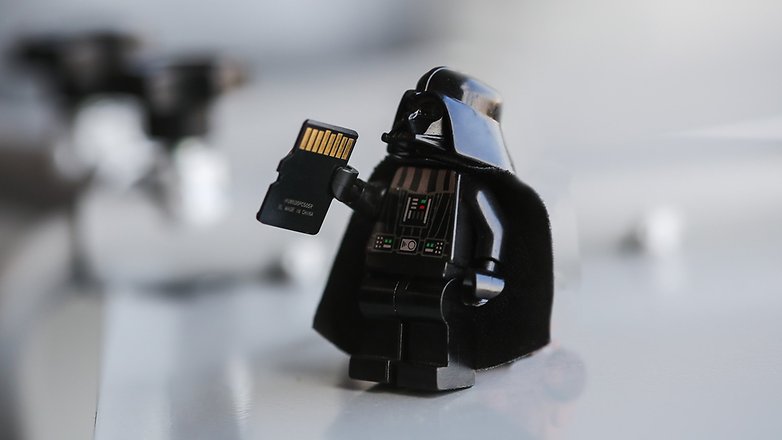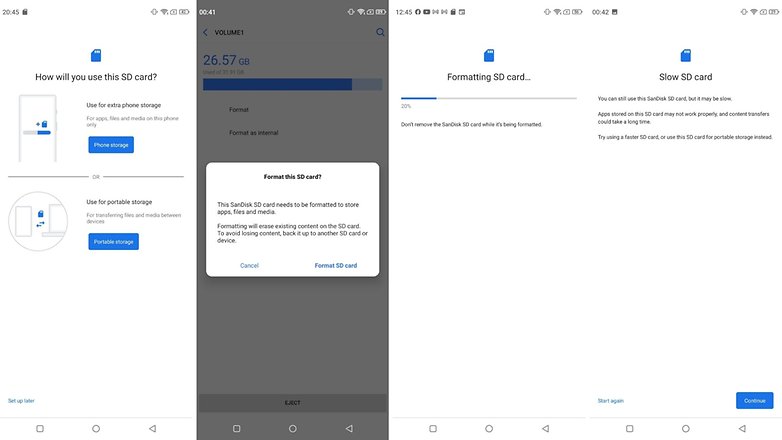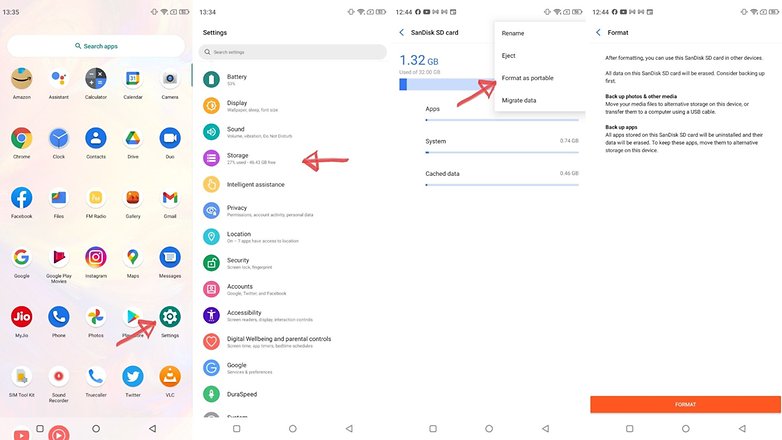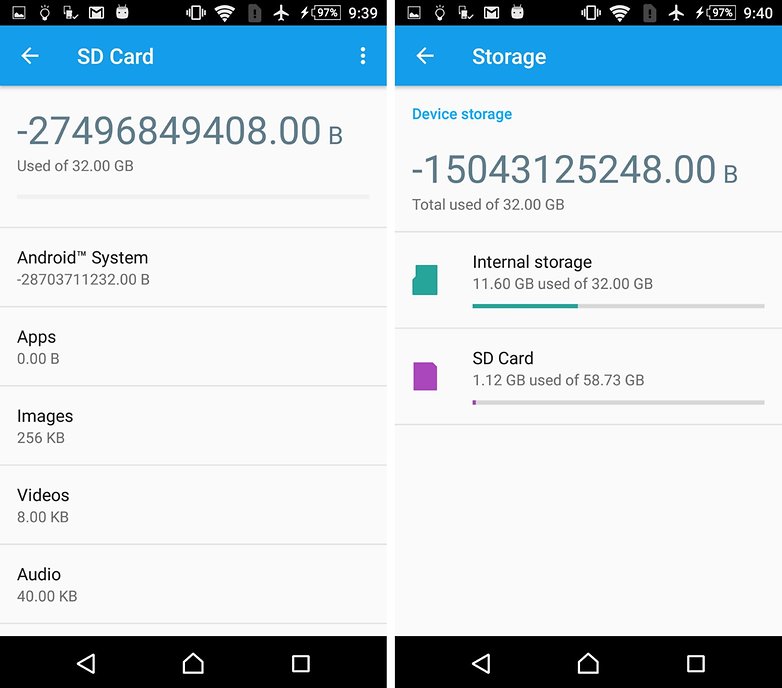Motorola Format as Internal Motorola Format as Internal Again
In this article, we attempt to learn more about the adoptable storage characteristic and meet why the feature failed to take hold of on. You lot will also acquire if you can still utilize the feature on a smartphone running Android x/ Android xi and, if it can be done, what exactly practice y'all need to do to activate information technology.
Jump to
- What is adoptable storage?
- Advantages of adoptable storage
- Disadvantages of adoptable storage
- How to use MicroSD carte du jour as internal storage on Android
- How to stop using MicroSD card every bit internal storage on Android
- What to do if your phone doesn't permit you lot to format microSD as internal retention
What is adoptable storage?
First things first, adoptable storage lets you employ microSD cards as internal storage on Android smartphones. But what was the need for this feature, and is it even relevant today? That'south what we intend to discover out. Permit'south start with a bit of history to actually get to the crux of the matter.
Around 2013-14, as Android smartphones exploded in popularity - especially in emerging markets like India, Due south Eastern asia, and China - there was a surge in demand for lower-priced, entry-level smartphones. Consumers who purchased these phones soon had to argue with a major irritant: low internal storage.
If you recollect, entry-level smartphones of the time only came with 4GB or 8GB of storage. With apps getting increasingly bigger in terms of file sizes, and about of these apps beingness installable only on the internal storage, these phones were notorious for throwing up depression internal storage alarm messages.
This prompted Google to innovate a feature chosen adoptable storage with Android half-dozen.0 Marshmallow. The thought seemed ingenious at the time. With a bulk of these low-finish phones featuring a MicroSD card slot, adoptable storage did exactly what it said. It "adopts" the external storage and formats it in a way that behaves like internal storage.
What are the advantages of adoptable storage?
The adoptable storage feature did come as a sigh of relief for users of depression-terminate smartphones who were frustrated with constant "low internal storage" warnings. It allowed them to quite easily aggrandize the internal storage without spending likewise much coin.
All that was needed was to format the card in a special way, and voila! They had tons of fresh, new internal storage at their disposal. The process of formatting the SD card as internal storage too wasn't very daunting for users as several low-terminate smartphones from this era automatically prompted users to format the menu in easy steps.
- Also read: How to pick the best MicroSD carte for your Android
Upon formatting the card as internal storage, the process besides migrated shared storage contents (typically mounted at /sdcard) to the newly adopted media. This footstep helped users free a lot of valuable infinite on the internal storage - thereby marking an terminate to those annoying internal storage bulletin warnings. All in all, adoptable storage seemed like a godsend for people with smartphones that had depression internal storage, correct?
Well, there was a take hold of! Several catches, actually.
What are the disadvantages of adoptable storage?
Lack of support from major brands
While adoptable storage did solve the issue of low internal storage for several users, some smartphone brands chose non to include this feature fifty-fifty on their low-end phones. One key example was that of Samsung, which correct from the start chose non to implement the feature on their devices.
Samsung's caption was that using microSD cards as adoptable storage affected the overall performance of the device. They also explicitly said that the feature was only intended for utilise on depression-end smartphones while also disabling the characteristic on their own low-end devices! Samsung's compatriot LG was not too slap-up on joining the adoptable storage party.
Brands that did back up Adoptable storage on their devices included HTC (which named the characteristic Flex Storage), Blackberry, and Motorola. Backing from major smartphone vendors notwithstanding, the feature itself did come up with inherent issues.
Performance bug
While Samsung might take had other reasons to disable the adoptable storage characteristic on their devices, the company wasn't lying when it said information technology came with inherent performance issues.
Almost SD cards of the time were much slower (in terms of their read/write speed) when compared to the internal wink module. This meant that every single task that involved the adopted MicroSD carte took longer to execute. And with nearly of the devices that had this feature already falling into the depression-end category, it but made the phones slower than they already were.
- Also read: Internal storage is notwithstanding ameliorate than MicroSD cards
In essence, a solution that was intended to solve a major irritant (that of low internal storage) only ended up creating another problem (that of slower functioning).
Not every app supported adoptable storage
The adoptable feature came with a major caveat.
App developers were required to manually enable this feature on their apps using theandroid:installLocation attribute. And many app developers chose not to do it - mainly because of the aforementioned performance issues. WhatsApp, for case, which was notorious for clogging the internal storage on phones with its big database files and multimedia folders, never came down to supporting adoptable storage.
Disabling adoptable storage is a pain
The very reason for the popularity of microSD cards is their portability. You tin can simply remove the cards and toss them around (merely kidding), and put them inside another smartphone or device with ease. This was no longer possible with MicroSD cards that were formatted to behave like internal storage.
To disassociate the MicroSD card to be used on some other device, information technology had to exist reformatted as a portable storage device. This meant you would demand to backup all the data stored on this card elsewhere. Fifty-fifty worse was the fact that all the apps that were installed on the bill of fare would take to exist uninstalled and reinstalled again.

Then at that place is the question of what happens when the MicroSD card is removed from the system without doing all these steps. Turns out it creates a serious trouble for your apps. After all, they tin no longer access their data. Since the partitions with your operating organization and the information for a manufacturing plant reset are still stored in the internal memory, a removed or cleaved SD carte du jour tin can't do whatever damage. When nosotros removed the MicroSD carte, app icons were quickly replaced by placeholders, which were immediately restored when reinstalled.
If you lot lose the SD card or it has a defect, your data is lost. Since these are encrypted as the internal retention, you should not hope for information recovery.
How to use a MicroSD card as internal storage on Android
As of 2021, adoptable storage is non a very sought-after feature even on low-finish Android smartphones considering most of them have a decent amount of internal storage already. For the purpose of this article, I tried several handsets running Android ten/Android 11 - but to come out disappointed.
In fact, I was almost convinced that newer versions of Android practice non support this characteristic in 2021. That was until I got hold of a smartphone from a shut friend fabricated by Indian smartphone maker Micromax. The handset, known as Micromax IN Note ane, is fairly new and was released in late 2020. It runs Android 10 and, surprisingly, supports the adoptable storage feature - in 2021!
When I inserted a MicroSD carte into the slot, the phone immediately prompted me to enquire how I wanted to employ this carte du jour. And this is what you should expect to happen when you insert a card into a phone that supports adoptable storage.

As seen in the paradigm above, the phone will warn you near the read/write speed of the card being slow in one case you lot format it accordingly.
In case your telephone does not prompt y'all automatically, try these steps
- Put the SD carte on your Android phone and wait for it to be recognized
- OpenSettings > Storage
- Tap the proper name of your SD bill of fare.
- Tap the 3 vertical dots on the superlative correct corner of the screen.
- TapStorage Settings.
- Select Format as internal option.
- TapErase & Format at the prompt
- Android will then offer to migrate your information.
How to stop using MicroSD card every bit internal storage on Android
As mentioned earlier in this article, if you want to stop using a MicroSD carte du jour that has been formatted every bit internal storage, it is not a simple procedure every bit removing it directly. To do this, you volition need to reformat the bill of fare every bit portable. Here's how you can do it on Android 10.
- Open Settings > Storage
- Tap on the name of the SD bill of fare
- Tap the three vertical dots on the top right corner of the screen and tap Format as portable
- You will meet a alarm screen that tells you what happens side by side. Make sure all the data on the SD bill of fare is backed upwards elsewhere.
- Tap Format

Now that you have learnt how to format and reformat your MicroSD card to use equally internal storage, I am sure most of your queries regarding this topic have been answered. And you might as well stop reading by this point.
But what if yous have an quondam smartphone lying around? And what if it does not support adoptable storage natively? Well, in such a state of affairs, there are some workarounds. However, these are very outdated and may non work well as they used to one-half a decade agone.
The steps below are applicative for really outdated Android versions.
What to do if your telephone doesn't allow you to format microSD as internal memory
Some unhelpful smartphone manufacturers disable Android'due south default function to format microSD as internal retention by hiding the selection from your telephone. However, information technology's even so possible to activate this using a PC, no root or special privileges required.
The exact steps vary depending on the Android version of your phone. This technique worked well with Android 6.0 Marshmallow and Android 8.0 Oreo, still, we encountered difficulties working with Android Nougat.
- What to do if your phone runs Android 6.0 Marshmallow
- Issues with system updates and Nougat
For phones using Android 6.0 Marshmallow
When a MicroSD card is formatted equally internal memory, apps can exist fully stored on it. This means that if you download applications with a total size of ii GB, and so there should exist 2 GB of infinite taken upward on the SD carte. If, however, the MicroSD card is just formatted as a backup memory, this is non the instance, as PLATYPUS_DIARRHEA writes on Reddit.
Just because the card option is invisible doesn't mean that it doesn't work. A few days afterward the Reddit post, a command-line prompt became known, with which you could also format MicroSD cards every bit internal memory on the Galaxy S7. We have successfully tested the instructions with the Samsung Galaxy S7, the Sony Xperia Z5, and the LG G4, while running Android half dozen.0 Marshmallow.
All three smartphones run on Android 6.0 Marshmallow and have a slot for MicroSD cards. In add-on, the menu option for formatting the MicroSD bill of fare equally internal retention is missing. The entry is merely bachelor on HTC One A9 and on Motorola in all Moto smartphones.
Why Samsung, LG, and Sony do not show us this bill of fare pick escapes me. I connected each of the three smartphones to the reckoner, and each had one MicroSD carte du jour inside.
Then I typed into the ADB tools the command-line commands that Paul O'Brien described in his blog postal service. As before long as y'all have the control line window open up and the smartphone connected, you tin enter the beginning command:
- adb vanquish
Now the command line is ready for you to issue organization commands to your smartphone. In this case, we desire to format the SD card or a part of its retentivity equally internal retentiveness. Even if Sony, Samsung, and LG deny the states the possibility via the UI, we can withal transfer the command to the smartphone as a panel command. Outset, nonetheless, we need the ID of the SD menu. You will find information technology with the following command:
- sm list-disks
In my case, the disk is called 179.64. For you, peradventure, information technology is unlike. Note the exact identifier. In the next control, we will format and partition the MicroSD carte du jour. Your content will exist deleted. If important files are on the card, copy them to another disk. If y'all want to go along the MicroSD card permanently in the smartphone, you lot tin can now partition all of your memory. To do this, type:
- sm partition deejay: 179,64 private
The functioning takes several seconds or minutes, depending on the capacity of the memory carte du jour. If you desire to use a sure pct so that it tin can be read by other devices, you must exclude information technology from the private partition. The fifty:50 partitioning command looks like this:
- sm partition disk: 179,64 mixed 50
This is the end of Paul O'Brien'due south guide, only not the end of the work. If y'all now want to utilize the adopted memory every bit such, you lot must also drift apps and information. This tin can exist washed through the storage section of your Android settings menu. Tap the MicroSD card, and then move to the meridian right of the carte du jour and click on Move data. You cannot select this menu item before partitioning.

Now, and in the hereafter, downloaded apps are fully written to the MicroSD carte. Only organization apps and updates use the internal retentivity. This means that you should never again get error messages due to lack of space if an app update is pending.

Bug with system updates and Nougat
Some readers have reported difficulties when installing system updates from Android six subsequently using the methods in a higher place. The update to Android 7.0 Nougat specifically doesn't seem possible with the manually partitioned MicroSD cards, as described below. Our test devices with Android vii.0 Nougat do not even respond to the console commands shown below.
In the absence of documentation on the cyberspace, we can therefore only advise y'all to reverse the steps described beneath earlier a organization update. Back up photos or music on your computer or in the cloud and free upward as much memory on the SD card and smartphone as you lot can.
Uninstall unnecessary apps and migrate your information back into the internal memory. Then format the MicroSD card as removable media. Merely then is it condom to install an Android update.
We have finally come to the end of this article. Do let us know what yous think of adoptable storage. Have y'all managed to use this feature on your phone?
This article was heavily revised in May 2021 to reflect fresh changes. Older comments and some older steps have been retained.
Source: https://www.nextpit.com/how-to-format-microsd-cards-as-internal-storage
0 Response to "Motorola Format as Internal Motorola Format as Internal Again"
Post a Comment